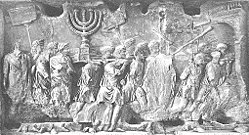Temple denial: Difference between revisions
→Endnotes: all footnotes |
→References: in what universe is an opinion column a "reference" to be separated like this? |
||
| Line 46: | Line 46: | ||
| id = ISBN 159698029X |
| id = ISBN 159698029X |
||
}} |
}} |
||
*{{cite web |
|||
| last = Reich |
|||
| first = Walter |
|||
| date = May 30, 2007 |
|||
| url = http://www.latimes.com/news/opinion/commentary/la-oe-reich30may30,0,6374582.story |
|||
| title = King Herod's return |
|||
| format = Opinion column |
|||
| work = |
|||
| publisher = [[Los Angeles Times]] |
|||
| accessdate = 4 September 2009 |
|||
}} |
|||
[[Category:Historical revisionism (political)]] |
[[Category:Historical revisionism (political)]] |
||
[[Category:Pseudohistory]] |
[[Category:Pseudohistory]] |
||
Revision as of 20:36, 4 September 2009
"Temple Denial" refers to the theory that the Temple in Jerusalem never existed.
History

The term "Temple Denial" was used by Dore Gold, President of the Jerusalem Center for Public Affairs and former Ambassador to the United Nations, in his 2007 book, The Fight for Jerusalem: Radical Islam, the West, and the Future of the Holy City. Israeli writer David Hazony has described the phenomenon as, "a campaign of intellectual erasure [by Palestinian leaders, writers, and scholars] ... aimed at undermining the Jewish claim to any part of the land," and compared the phenomenon to Holocaust denial.[1][2]
At the 2000 Camp David Summit, Yasser Arafat insisted that the Jewish Temple existed in Nablus, not on the Temple Mount in Jerusalem.[3][4] Gold describes Arafat's assertion as part of “A campaign by Arafat to completely delegitimize the Israeli claim to the city.”[4] He wrote that Temple denial has become a “new Palestinian dogma.”[4] Others have described Temple denial as part of an Islamic strategy to rule "all of Jerusalem minus the Jews.[5] Or as an unfair return for Israel's attempt to make peace at Camp David.[6]
According to Dore Gold, in the wake of Arafat’s remark at Camp David, Temple denial “spread across the Middle East like wildfire,” and even “subtly slipped into the writing of Middle-East based western reporters.” Citing Time Magazine and its reporter Romesh Rotnesar as an example.[7]
Palestinian Authority President Mahmoud Abbas has also been accused of "Temple Denial" for asserting that while “the Jews claim that 2,000 years ago they had a temple [in Jerusalem], I challenge the claim that this is so.”[7][8]
Others compare Arab denial that the Temple existed to Holocaust denial, accusing Arab governments of promoting Temple denial for political reasons "in order to portray (Jews) as alien interlopers in the land of Israel."[9]
A growing phenomenon
According to Lela Gilbert, Temple denial is a "growing phenomenon" both in America and in Europe, “particularly in leftist intellectual circles." She believes that the problem is exacerbated by the simple fact that there are no remains of the Jewish temples visible on the top of the Temple Mount, where only Muslim buildings now stand.[10] According to Dore Gold, speaking at the Jerusalem Center for Public Affairs, Temple Denial is a growing phenomenon, used as a “political tool” meant to undermine Israeli claims to Jerusalem, and by European academics who for “ultra-secular” reasons wish to deny the reality of the ancient temple.[11]
Aaron Klein has written the efforts by Muslim leaders in the West to oppose Temple denial have failed because Muslims in the Middle East believe leaders who use Temple denial to make "Islam the only legitimate actor" in Jerusalem.[12]
Academic Temple denial
Dore Gold has accused a number of academics in the Muslim world and some in Western universities of Temple denial, including members of The Copenhagen school in biblical exegesis and Professor Nadia Abu El Haj of Barnard College.[13]
Denial by artifact destruction
According to George Washington University professor Walter Reich, "temple denial has turned into temple removal," as Palestinian authorities have removed and discarded archaeological artifacts from the Temple Mount.[14] According to archaeologist Gabriel Barkay of Bar Ilan University, physical remnants of the temples still visible in the 1960’s and 70’s have now been covered up or removed by the waqf.[10] Dore Gold points out that the archaeological material removed from the Temple Mount without archaeological supervision by the waqf as a physical form of Temple denial is being sifted for significant artifacts by Dr. Gabriel Barkay in the Temple Mount Antiquities Salvage Operation.[15]
See also
Footnotes
- ^ Hazony, David. "Temple Denial In the Holy City", The New York Sun, March 7, 2007.
- ^ Gold, pp. 10 ff.
- ^ King Herod's return, Walter Reich, Los Angeles Times, May 30, 2007.
- ^ a b c Gold, p. 11
- ^ Doyle, Tom, Two Nations Under God: Why You Should Care about Israel, B&H Publishing Group, 2008, p. 6.
- ^ The 9th of Av's New Tears, Los Angeles Times, July 30, 2009, Yisrael Medad [1]
- ^ a b Gold, p. 12
- ^ Is Abu Mazen a Partner for Peace? Let’s ask him, Alan Silverstein, May 21, 2009, New Jersey Jewish News.
- ^ Salvation is From the Jews (John 4:22): The role of Judaism in Salvation History from Abraham to the Second Coming, Roy H. Schoeman, Ignatius Press, 2003, p. 2.
- ^ a b Gilbert, Lela (August 14, 2008). "Digging out the truth?" (Newspaper article). The Jerusalem Post. Retrieved 4 September 2009.
- ^ http://www.youtube.com/watch?v=enT0-OnpPHM
- ^ Klein Aaron, Schmoozing with terrorists, WND Books, 2007, p. 74.
- ^ Gold, pp. 13-14
- ^ King Herod's return, Walter Reich, Los Angeles Times, May 30, 2007.
- ^ Gold, p. 16.
References
- Gold, Dore (2002). The Fight for Jerusalem: Radical Islam, the West, and the Future of the Holy City. Regnery Publishing. ISBN 159698029X.
{{cite book}}: Cite has empty unknown parameter:|coauthors=(help)
